Lego build a minifigure

Игорь, тигр был чуть ранее, а если точее, то в конце октября появился на стенде, как и еще две хэллоуинские минифигурки. А новогодние у меня заказаны из Европы еще год назад



Дарья Куприянова запись закреплена

Дарья, спасибо за подробный обзор, мне очень поможет твой пост, чтобы правильно собрать фигурку. Планирую сегодня поехать.


Сергей Шабанов


Алексей Крутов


Сергей Шабанов ответил Алексею

Виктория Макарова
Дарья, спасибо за фото хоть бы были все у нас

Дарья Куприянова запись закреплена



Юлия Пинчук

Дарья Куприянова запись закреплена


Алина Белогурова

Виктория Макарова
Какая красота с отличным обновлением


Дарья Куприянова запись закреплена

Юлия Пинчук
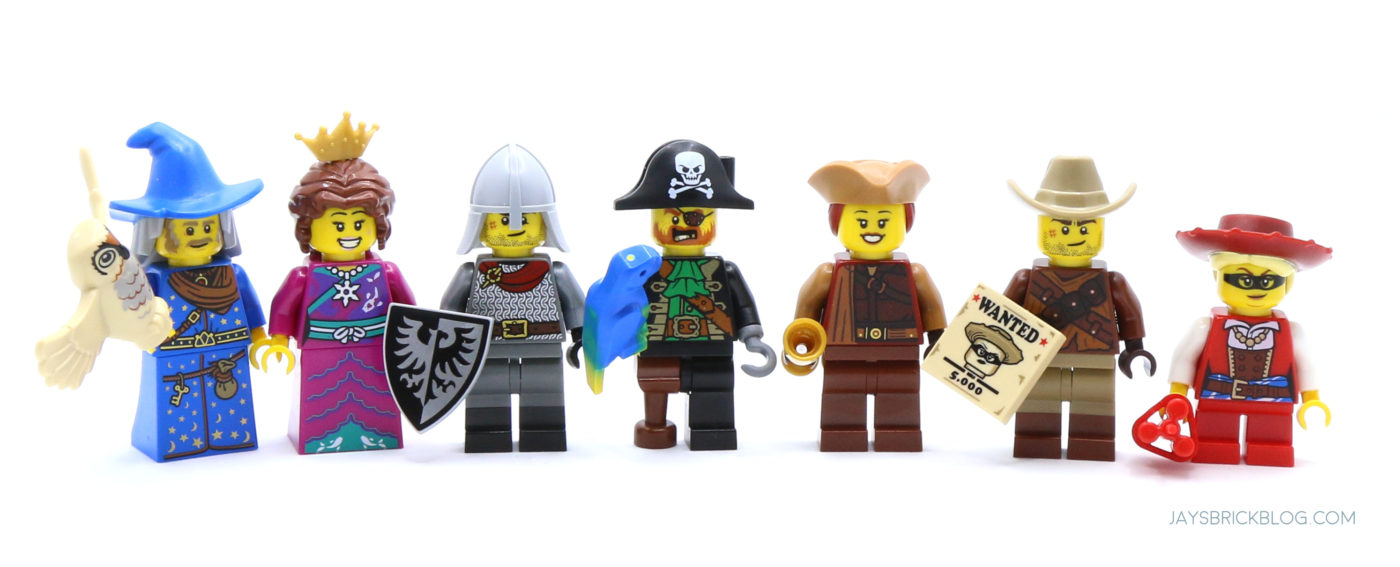
As I alluded to in my post about the new White/Silver Falcons minifigures a couple of days ago, I’m now happy to share a quick review of all the new LEGO Build a Minifigure exclusives that are part of the Q2 (Quarter 2) 2022 release! As a strategy to attract people into LEGO stores, LEGO…
Preview: Melbourne Central’s new LEGO Certified Store – flagship experience!

Yesterday, I had the opportunity to check out the brand new LEGO Certified Store at Melbourne Central, ahead of the grand opening to the public on Saturday, 7 May 2022. The new LEGO Store at Melbourne Central (and 14th in Australia) takes the crown as the largest LEGO store in Australia and the Southern Hemisphere,…
Are LEGO introducing a new Castle faction – the White Falcons?

Hear me out, I think I’m onto something here. I believe LEGO may be introducing a brand new Castle faction – the White Falcons, to oppose the classic Black Falcons faction. I was at the Legoland Discovery Centre Melbourne to check out all the 1 May launches, and stumbled upon a whole set of new…
LEGO’s Online Build a Minifigure beta now available in APAC and Europe!

Update (15/4): The Build a Mini seems to have gone down temporarily. Word on the street is that some critical bugs have been identified, surrounding editing/deleting minifigures, so it looks like LEGO have temporarily disabled the service. As it’s the Easter long weekend, I don’t expect this to be fixed immediately, so maybe check back…
LEGO Goats spotted in Build a Minifigure Stations! (April Fool’s!)

I went into my local LEGO Store (in Melbourne) today, to check out some the new April 2022 releases on shelf. One of my rituals when I go into store is to check out the Build a Minifigure station for new parts, characters and accessories. LEGO have been ramping up their Build a Minifigure offering…
New Build a Minifigure exclusives for Q3 and Q4 2021 revealed!
September 2, 2021 By Jay 3 Comments

New Build a Minifigures for Q3 and Q4 (third and fourth quarter) of the year have emerged in Australia, featuring some never-before seen characters, and recoloured elements that are exclusive to Build a Minifigure Stations found in LEGO Stores, and Legoland Discovery Centres around the world! These became available on the Legoland Discovery Centre Melbourne…
Welcome!
Hello and welcome to Jay's Brick Blog. In here, you'll find independent LEGO set reviews, commentary on LEGO trends & news, bargain hunting tips and an inside look into the life of an average LEGO fan. Find out more about me here
Minifigures, commonly referred to as a "minifig", or simply just "fig", are small plastic figures just over 1 1/2 inches (4 cm), or four bricks tall. They connect to LEGO System Bricks, and usually consist of 9-10 parts, though certain unique minifigures in some themes can have as few as 7 or more than 10 depending on the character they are intended to portray. The minifigure was designed by LEGO model builder Jens Nygaard Knudsen, along with other early minifigure designs. The modern minifigure was patented with the U.S. Patent office on Dec. 18, 1979, with Knudsen and Godtfred Kirk Christiansen as the inventors.
Contents
Design
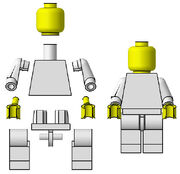
Anatomy of a minifigure
A basic minifigure is composed of several separate essential LEGO pieces: head, torso, arms, hands, hips, and legs. Minifigures typically come packaged as three separate parts in LEGO sets: head, torso/arms/hands, and hips/legs. Each basic minifigure has the same height as four normal stacked bricks. However, some head accessories, such as helmets and mohawks, can make minifigures slightly taller.
Minifigure heads are cylindrical and attach to the peg on top of the torso, which allows the head to rotate. This also allows special items to fit over the torso, such as air tanks, rucksacks, capes or breastplates. The standard heads (LEGO has made other forms of heads for weird aliens and such) also have a stud on top,which is the same size as studs on LEGO bricks, to which things can be attached. Head accessories are varied, including hair, helmets, hats, and hoods. These variations allow minifigures to be highly customizable. Blank versions of the minifigure head element are often used to replicate other objects in Town sets - most commonly lamps and electrical appliances.
Minifigure torsos have a fairly traditional shape, flat across the bottom and narrowing towards the curve of the shoulders. The torso is fitted with a peg on top to allow for the connection of the head and/or other accessories. Torsos are often printed with various details reflecting the design of a character, including blank spaces indicating a slimmer body type as on a female character. Modified torsos also exist, such as ones from the Ninjago theme that are designed to go on top of other torsos to provide additional limbs; these include an overlapping piece on the upper torso and can also include shoulder armor.
A few LEGO arms, such as some of the Minifigures theme, have printings on them. The hands of a minifigure are shaped similarly to a "C", which allows them to hold many LEGO accessories, as well as plates and tiles (by their sides), or on the top of the minifigure's hand. There are hundreds of different accessories, including axes, magic wands, cups, guns, swords, food, documents, etc. The tops of the hands are also roughly the same size as the studs on LEGO bricks, allowing various LEGO pieces to be placed on top of them. LEGO has made extra pieces that fit in the hand socket, like pirate hooks or boxing gloves. Minifigures such as Vampire Bat and Man-Bat have combined wing/arm pieces.

The legs can rotate independently beyond 90 degrees forwards and approaching 45 degrees backwards, making a total rotation of 135 degrees. They also attach to normal LEGO bricks in either a sitting or standing position. There are long legs like those of the Toy Story character Woody, which can still rotate, and short ones like Yoda's or Dobby's, which cannot rotate. These short legs are most commonly used for children-type minifigures in the City theme and to portray short-statured non-human characters/creatures in some licensed themes, notably Star Wars and Harry Potter. There are also legs called "Medium Legs" which are commonly used for teenage characters in Harry Potter. LEGO has made a peg leg that can fit in the leg sockets, seen in minifigures such as Captain Brickbeard and Rizzo. Minifigures like Centaur and Cooper have more than two legs and minifigures like Genie and Nadakhan don't have legs. In the 7777 LEGO Trains Idea Book, a novel use of the leg part was to function as an angled support for railway sleepers on an inclining bridge viaduct carrying a train.
According to LEGO.com, most minifigures are coloured yellow to display equalization in ethnic society. The use of different tones of colour came about when LEGO decided that minifigures should look "authentic" to the way they were portrayed, this later expanded into licensed themes such as Star Wars to display correct characterization. The yellow coloration is still used in unlicensed themes, such as Ninjago, for purposes of equalization in ethnic society. [1]
History
Original Figures

The first minifigures from 1974
The original LEGO figures were released in 1956 in HO scale in a Town Plan system supplemental set, 1271 Traffic Police.
Early Minifigures appearing in 1974 were known as LEGOLAND Minifigures along with their large counterpart Homemaker Figure Maxifigure and followed by the Duplo figure in 1976. The early minifigures were similar in height to modern minifigures but have one-piece non-movable legs and a one-piece torso. They were blocky and their arms were depicted as being in their pockets. The figure's heads were the same as those of minifigures, but they were blank. Their only range of motion was at the head. They also came with hats or hairpieces. In the LEGO Book, they were modified by the designers of the minifigures continuously, going through various stages with movable arms, circular hands, and textured faces. Eventually, the designers settled upon what is considered a minifigure today.
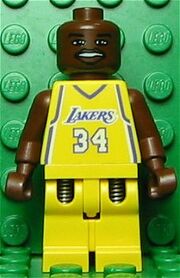
Shaquille O'Neal, an example of a naturally skin-toned minifigure
The first minifigure with movable arms and legs was a policeman released in the year of 1978, with seven different figures in Castle, Space and Town themes. Many Town minifigure torsos had a sticker instead of a printed pattern on one. The Castle minifigures have plain torsos, instead of having a body part with a sticker/symbol on it. The Classic Space minifigures were the first to be printed, but their printing rubbed off easily. Until 1989, minifigures' heads only had a simple facial expression of two black dots for eyes, and a black curved smile. In that year, minifigures in the Pirates theme were produced with different facial expressions. The Pirates minifigures also included hooks for hands, and wooden legs, the first departure from the traditional hands and legs. In 1994, Islanders introduced the first minifigures with leg printings and reused this feature for Major Kartofski later that year. In mid-2000, Football introduced the first minifigures with back printings, a feature that LEGO would expand in 1349 LEGO Studios Steven Spielberg MovieMaker Set later that year. In 2001, the Harry Potter series’s 4702 The Final Challenge introduced the first minifigure with a double-sided head. In 2002, the first minifigures with short legs were published. In 1997 the release of the Western line of sets saw the introduction of the first minifigures with racial characteristics, with the Indian Minifigures. In 2003, the first Minifigures with natural skin-tones — as opposed to the yellow previously used — were released as part of Basketball; these minifigures also represented specific people. The following year, the use of natural skin tones was expanded to licensed products, such as Indiana Jones, Harry Potter and Star Wars minifigures. As of 2003, LEGO had produced four billion minifigures. There are at least 3655 different minifigures produced between 1975 and 2010 and the number of new minfigures per year is increasing rapidly. In 2010 more than 300 new minifigures were introduced. [1]
Variations

Technical drawing of a Minifigure
While almost all minifigure torsos, arms and legs are the same size and shape, some sets and themes have included figures that differ from this standard. The Alien Pirate and Alien Commander minifigures have a normal trans-green head with no expression but have a neck piece that resembles the face of the alien, and a hat piece that resembles the brain. The minifigure's head then resembles a specially moulded head. Some minifigures for women, particularly in Castle and Pirate sets, have used large 2x2x2 sloped bricks instead of legs to resemble dresses or skirts (slightly longer than legs). Skeletons, in Pirate and Castle sets, have the standard minifigure head, but have specialized skeletal arms, legs and torso (which are still detachable from each other)-in addition, a new version of skeleton torso was produced with more articulate arms.
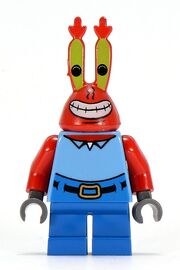
Mr. Krabs, a minifigure with shorter legs than traditional
Shorter legs, without joints at the hip, have been used for children, Yoda and Ewoks in Star Wars sets, Goblins and House Elves, such as Dobby in the Harry Potter sets, Dwarfs, in Castle, SpongeBob and Mr. Krabs in the SpongeBob SquarePants sets, Short Round in the Indiana Jones sets, Stinky Pete and the Aliens in the Toy Story sets, and more. Pirate minifigures have had peg legs (one leg and one peg leg) and Hooks for hands, later used in other themes such as Adventurers, Alien Conquest, Alpha Team, and Legends of Chima. The minifigures Squid Warrior from Atlantis and the Alien Commander have legs that resemble tentacles. Hagrid, from Harry Potter, uses a larger minifigure, with only the head being separable. Lately, some minifigures, such as Woody have also had heads that differ from the traditional cylindrical shape. Traditional accessories, such as hats and helmets, cannot be placed on these different heads. Examples include Stinky Pete, Yoda, Ewoks, Dobby and Goblins as mentioned above. Some minifigures, such as Chewbacca, SpongeBob and Thi-Sen have head pieces that fit like ordinary heads but end up covering most or all of the figure's torso piece. In Orient Expedition, a subtheme of Adventurers, there are large figures (Yeti, Tygurah, Jun-Chi, all of which were made of a large pair of legs and a torso). There has also been a taller type of minifigure leg, released in Toy Story, to allow for a height different between Woody and Buzz while allowing Buzz to remain taller than some others. Woody, Jessie and Zurg also had longer arms so they're more to scale with the longer legs.
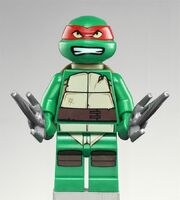
Raphael, a minifigure with a custom head that cannot use hair or a hat
Child-friendly versions of minifigures, which are much more difficult to take apart, have also been designed. Plus, some of the newer figures have special features that can light up (such as lightsabers and flashlights). By pressing down on their heads, their flashlight part (which is also a lightsaber handle and is one piece with the hand and arm) lights up. While this adds a new feature, these minifigures cannot come apart into as many pieces, which could discourage those who wish to customize them. The top of their heads can come off, because inside of that is a battery. However, it is not especially easy to do so and can damage them. Their heads can also come off, but it is not suggested because the heads connect to the body where the electricity travels to the arm.
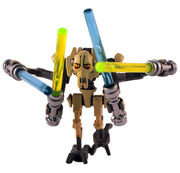
General Grievous, a minifigure made of special pieces
Minifigures built from special pieces were first introduced in Star Wars. Martians are builds for five pieces: two double arms, mechanical torso, a combined leg piece and a head. This formula is repeated for many Star Wars droids. Battle droids follow the same pattern, while Super Battle Droids have the head fixed to the torso, General Grievous has space for four arms and IG-88 has a head constructed from LEGO elements. Other droids, such as Droidekas, Spider Droids and Pit Droids, are constructed entirely from ordinary LEGO elements many of which were originally made for the droid minifigures but are none the less often considered minifigures. R2-D2, and other Astromech Droids, are constructed from specialized elements; with a separate top, body and two legs. Recently, the robots of Exo-Force have a design similar to the battle droids, but have separate legs and movable hands, and the head fixed on a small torso. The minifigures C-3PO, Protocol Droid and TC-14 have a special molded head for characters in the Star Wars franchise. There are also Skeletons of a newer kind, who have a similar design to the battle droids. They still have a skeleton torso and legs, but their arms now can move articulately. In addition, in 2007 new Battle Droid arms were released, allowing droids and skeletons to hold their weapons straight up instead of sideways only. There have also been very rare minifigures released, such as a 14K gold C-3PO which only 5 were made, a bronze Boba Fett and a silver TC-14.
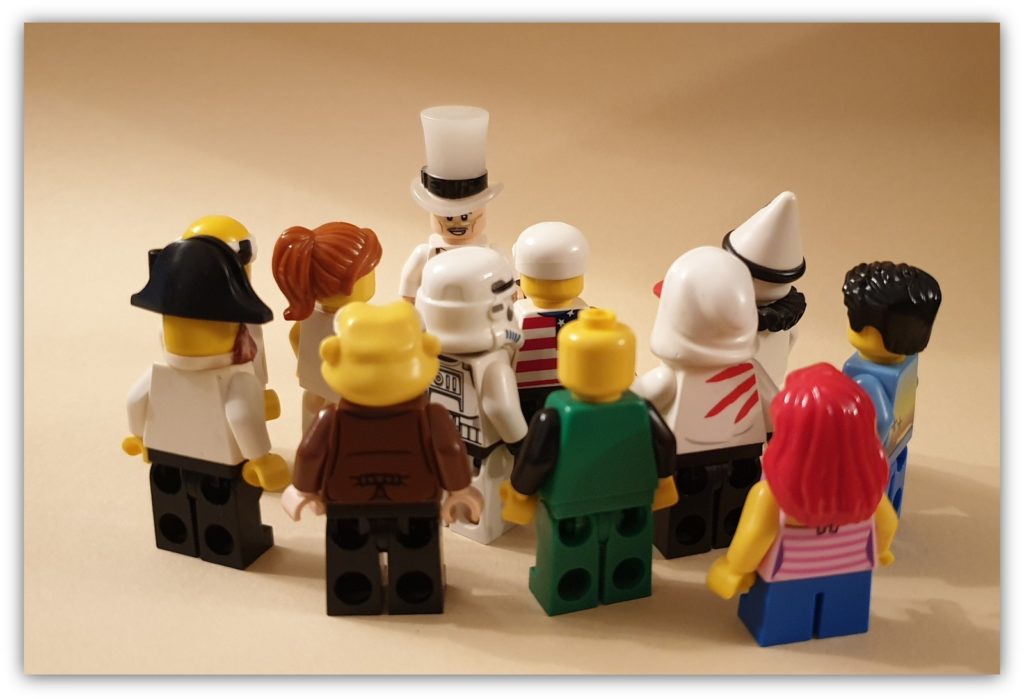
If you are working on a model LEGO village, or just have a LEGO shop, chances are that you’ve probably thought “I need more minifigures”. In this situation of course I’m not talking about specific collectible figures; whilst you can never have enough Storm Troopers, having a second Darth Vader is probably one too many. Especially in a Heartlake bakery. In this article I’m going to look at how you can expand your LEGO minifigure collection without just buying more LEGO construction sets.
Build-a-Minifigure Stations
If there is a LEGO store nearby to you then you have possibly the best initial source for figures – the Build-A-Minifigure station. These stands allow you to select all the elements to make three minifigures with an accessory. Depending on your store, what parts are available will vary, so you can’t go in thinking “I want to create three pirates” because you may end up coming out with a policeman, a clown and a chef-firefighter with a peg leg.
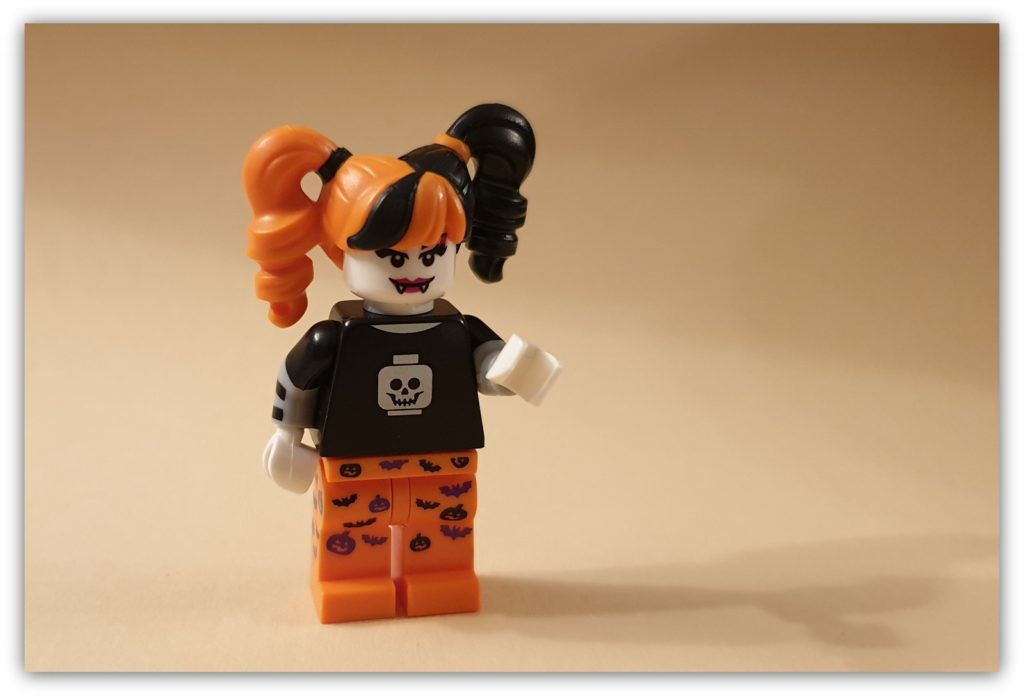
I have noticed that LEGO have started to release small batches of “special” parts into these bins, so it’s worth watching “the socials”. Whilst I missed the pink elephants released earlier this year, I did manage to get the Halloween parts which were quite fun.
Online Parts Re-seller
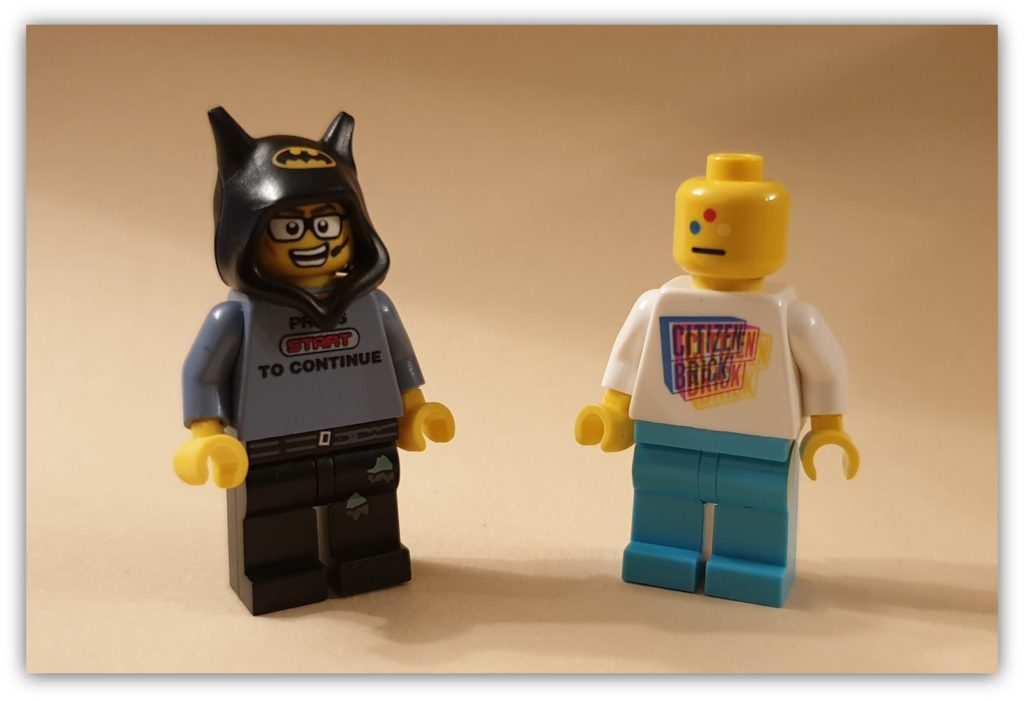
An alternate route to enlarge your LEGO minifigure collection would be to use online shopping websites. Bricklink is very much a key resource for those collecting figures or specific parts; typically, somewhere in the world someone is selling the figure or component that you need. Additionally, some traders will sell you large quantities of figures (or parts) so you can quickly recreate your mob scene.
My personal experience of Bricklink has been positive; the biggest challenge is that it’s not unlike walking into a sweet shop when you’re hungry; five minutes later and your shopping cart has loads of items in it and you only wanted a green brick!
eBay is similarly a good source for figures although you are much less likely to be able to buy in bulk. I would also note that it is far easier on Bricklink to compare costs across the sellers; it isn’t always as easy to be able to do the same on eBay.
Charity Shops and Car Boots
I am a regular visitor to charity shops and car boot sales. Whilst this is a very unreliable source for minifigures, I have been quite fortunate that I have been able to increase my LEGO minifigure collection at a very low price point. In these shops I have also found a LEGO car from the 1970s; as well as a rare Nesquik bunny minifigure in amongst the bricks.
Unlike clothes in charity shops I would not like to assume the cleanliness of LEGO from these locations; I always run these parts through my washing machine to get the “unknown ick” that might be on them!
Custom Printing
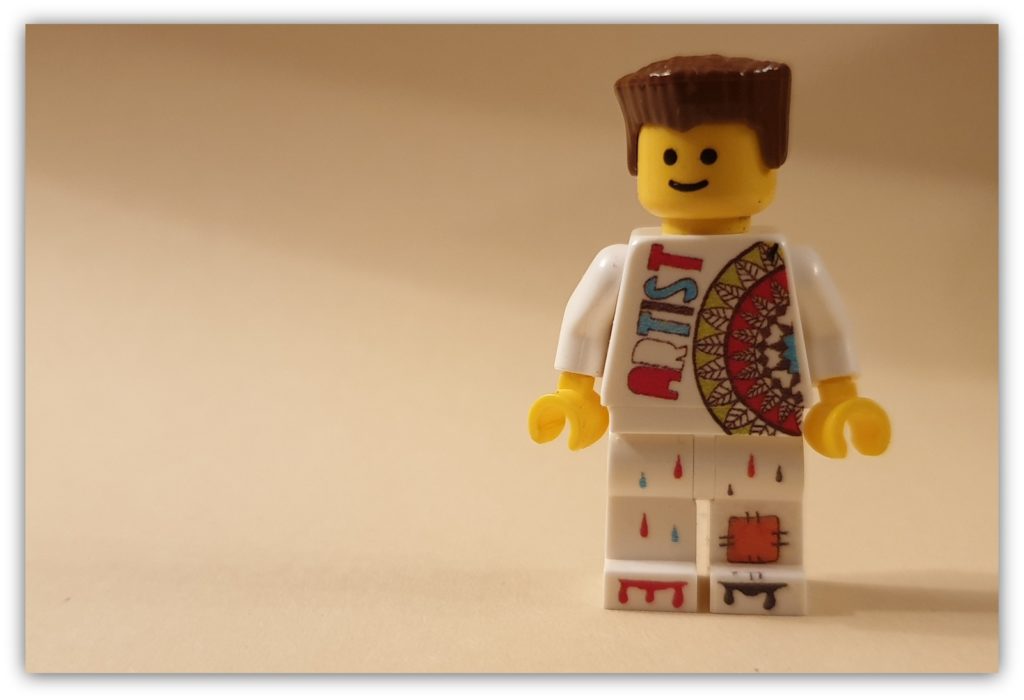
Although custom printing is not always the cheapest solution, this is also a route to getting more figures. Custom printing can be exclusive short-run prints (such as the Citizen Brick figure in an earlier image), or can just be something different from the standard (the torso print on my earlier Firestar Toys figure). Some companies will also offer the opportunity for you to create your very own one-off creations. The figure above is such an example; this was drawn by me and printed by minifigs.me through their “Doodlefig” offering.
LEGO Comics

One source that I keep going back to is the LEGO comics. These are released on a quarterly basis and themes now include: Star Wars, City, Friends, Ninjago and now Haunted House. On each release there will be a foil bag on the cover with typically a minifigure in it. Friends and Star Wars do seem to split this toy distribution so sometimes you will get something brick built to interact with rather than a figure (for example a bakery, or a spaceship). Occasionally though, these magazine double up on the figures (and on a recent Ninjago comic, had three figures).
Whilst the price point for these comics is generally around £5 there is a need to be mindful that this isn’t just for the figure; the comic is also comprehensive and fun too with stories, games and puzzles.
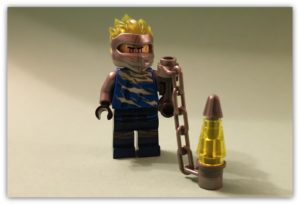
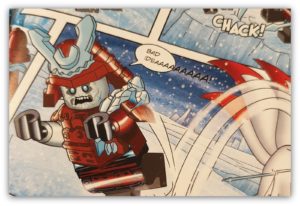
Above: Cartoon image from the LEGO Ninjago comic
Battle Packs and Fun Packs
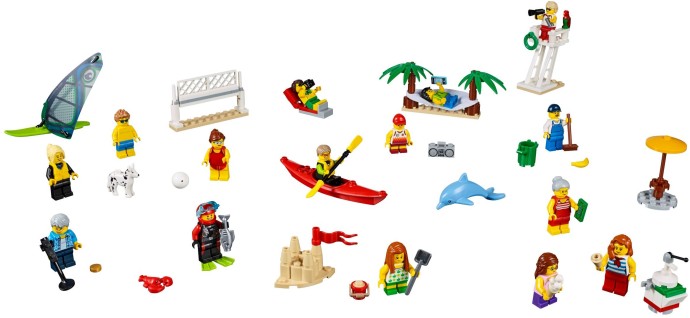
The last source that I could think of was actual LEGO sets. In the last few years, I have noticed that LEGO have released sets that have lots of figures and a reduced amount of building. These have been boxes and blister packs. These are reasonable in terms of price and a great way to expand your LEGO minifigure collection. The example above is set no. 60153-1, People Pack, Fun at the Beach.
My Own Citizens of Legolandia (a made up place)
I’m not sure how I managed to collect them, but as I wrote this article, I realised how many minifigures I now have; both collectible and not. In many cases, those I have put in the “non-collectible” boxes have had their parts swapped about to allow me to create the figure (or figures) I needed for a particular photo scene. Additionally, in the same box there are many spare heads, bodies (and just arms or legs!) as I have further adapted figures. And I know that all these figures have come from the sources that I have listed above!
Do you have any sources where you get your figures from, which wasn’t listed above? What’s your experience of buying spare figures? Let me know in the comments!
You Might Also Like
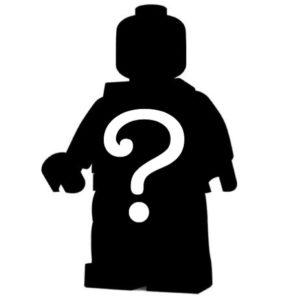
I Think I’m Living with a Superhero – Part 1
Are LEGO Minifigures Worth Collecting?
Let's be honest, we all love LEGO minifigures, but now and again, you just want something different, something special. Well, we've got it all right here! Check out the 100's of totally bespoke minifigures we've got on offer that you won't find anywhere else!

Category Celebrities

Category Film & TV

Category Sci-Fi

Category Gaming

Category Collections

Category View All

Create Your Own
Custom Minifigure
The Minifigure has evolved from an awesome toy, in to a powerful and just as awesome gift. We use the latest and greatest printing tech, to design figures based on your requirements and needs and with low minimum order quantities, they make the perfect gift for your event!
When you spend your big bucks, you'll earn Minibucks!
Every time you buy a minifigure, you'll earn Minibucks which can then be used to get great discounts on future minifigures.
Find out about all our new awesome products before anyone else and get all our latest discount codes and offers.
We're huge fans of LEGO but in particular LEGO minifigures (who would of guessed it!?). Theres something about the little guys and girls that we just love. We've always had a desire to create our own beyond what came with a set, it started off by just swapping heads and hairs or adding accessories to it, but quickly grew into a full time, award winning business. We now offer some of the best custom minifigures on the interwebs; all printed (no stickers!) in house using new LEGO parts and our custom Minifigure design service has been used by the likes of Google, Microsoft, Pixar and Fox Studios, to create epic Minifigures for shows and giveaways.
Читайте также:


